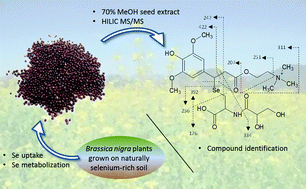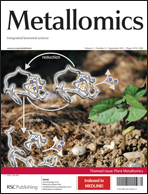Comprehensive speciation of low-molecular weight selenium metabolites in mustard seeds using HPLC – electrospray linear trap/orbitrap tandem mass spectrometry†
Abstract
An analytical methodology based on high-resolution high mass accuracy electrospray ionization (ESI) tandem MS assisted by Se-specific detection using inductively coupled plasma mass spectrometry (ICP MS) was developed for speciation of selenium (Se) in seeds of black mustard (Brassica nigra) grown on Se-rich soil. Size-exclusion LC-ICP MS allowed the determination of the Se distribution according to the molecular mass and the control of the species stability during extraction. The optimization of hydrophilic interaction of LC and cation-exchange HPLC resulted in analytical conditions making it possible to detect and characterize over 30 Se species using ESI MS, including a number of minor (<0.5%) metabolites. Selenoglucosinolates were found to be the most important class of species accounting for at least 15% of the total Se present and over 50% of all the metabolites. They were found particularly unstable during aqueous extraction leading to the loss of Se by volatilization as methylselenonitriles and methylselenoisothiocyanates identified using gas chromatography (GC) with the parallel ICP MS and atmospheric pressure chemical ionization (APCI) MS/MS detection. However, selenoglucosinolates could be efficiently recovered by extraction with 70% methanol. Other classes of identified species included selenoamino acids, selenosugars, selenosinapine and selenourea derivatives. The three types of reactions leading to the formation of selenometabolites were: the Se–S substitution in the metabolic pathway, oxidative reactions of –SeH groups with endogenous biomolecules, and chemical reactions, e.g., esterification, of Se-containing molecules and other biomolecules through functional groups not involving Se.

- This article is part of the themed collection: Plant Metallomics

 Please wait while we load your content...
Please wait while we load your content...